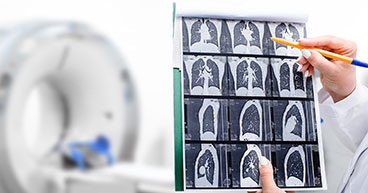
Lung conditions may be caused by a variety of medical conditions that share many of the same symptoms, like a cough, congestion or shortness of breath. They may also share similar causes, like smoking, an infection or allergies. That’s why it’s possible for these symptoms and conditions to be misdiagnosed. That’s not to say that you should worry that the bronchitis your doctor diagnosed is actually lung cancer. Instead, you should remain vigilant and monitor your symptoms, noting if they don’t go away with treatment.
“The important thing is to have adequate follow-up to make sure your treatment is working,” says Peter Baik, DO, Thoracic Surgeon at Cancer Treatment Centers of America® (CTCA) in Phoenix and Chicago.
“We’ve had patients who were treated for pneumonia with round after round of antibiotics, but they didn’t get better,” he says. “They figure, ‘Hey, it’s pneumonia,’ and then life happens, and they either forget to schedule a follow-up visit or the doctor’s office forgets to schedule one. Three, six, nine months go by, and they finally come back in because they’re still coughing. Lo and behold, it’s lung cancer.”
That’s why it’s critical to follow up with your doctor if you’re not getting better after a few weeks of treatment.
“You should feel better in a couple of weeks,” Dr. Baik says. “If things aren’t improving, it may be something else. And if it’s lung cancer and you start having pneumonia-like symptoms, a lot of times, those lesions are pretty big.”
In this article, we’ll explore:
- How lung cancer may be confused with other diseases, due to:
- How to spot the difference
- The importance of early screening
If you’ve been diagnosed with lung cancer and are interested in learning more about our treatment options at CTCA®, or if you’re interested in a second opinion about your lung cancer diagnosis and treatment plan, call us or chat online with a member of our team.
How lung cancer may be confused with other diseases
Similar symptoms
The main reason lung cancer is often misdiagnosed as other conditions is because it shares many common symptoms with those conditions. When symptoms do appear with early lung cancer, they often include:
- A lingering or worsening cough
- Chest pain
- Fatigue or weakness
- Hoarseness
- Shortness of breath
- Wheezing
Yet these symptoms commonly appear with other lung conditions, too, such as:
- Asthma
- Chronic obstructive pulmonary diseases (COPD)
- Pneumonia
- Pulmonary embolism
- Tuberculosis
These symptoms may make it difficult to distinguish between conditions. Also, one may sometimes disguise another, making diagnosis even more difficult. Yet a delayed diagnosis or misdiagnosis may severely impact a patient’s treatment options, quality of life and prognosis.
Consider pneumonia, a chest infection that causes inflammation in the air sacs of the lungs. It’s clearly a different condition from lung cancer, which develops when cells grow out of control and form tumors. Pneumonia is also very common in lung cancer patients. In fact, up to 70 percent of lung cancer patients are affected by pneumonia. Having pneumonia also increases a person’s risk of developing lung cancer. If you’ve had pneumonia, your risk for lung cancer is three times higher than people who have never had it.
While their symptoms align, pneumonia and lung cancer are caused by very different factors. Most lung cancers are caused by smoking or secondhand smoke. Other cases are generally caused by exposure to radon gas, asbestos or air pollution. Pneumonia, on the other hand, is caused by a virus, bacteria or, in some cases, a fungus.
Similar causes
Conversely, COPD, a condition that worsens over time and causes chronic coughing, not only shares symptoms with lung cancer; it also shares causes. Not only is smoking the No. 1 risk factor for both diseases, but even never-smokers with COPD are twice as likely to get lung cancer than those who don’t have COPD. For those who smoke and have COPD, the risk for lung cancer increases five times. Age is another causal factor linking the two diseases: The risk for both increases the older a person gets. Some researchers believe common genetic mutations also compound the link between COPD and lung cancer. DNA methylation, which occurs when the function of a gene changes but its structure remains intact, may stimulate lung inflammation in people with COPD and obstruct tumor suppressor genes that normally help control cell growth and repair damaged cells.
It's also possible that the persistent inflammation caused by COPD may lead to the destruction of cilia—the hair-like structures that line the airways and protect the lungs. With the cilia gone, higher concentrations of carcinogens—cancer-causing substances from cigarettes and the environment—may settle in the lungs.
Despite their commonalities, though, pneumonia, COPD and lung cancer are each treated very differently, which is why it’s important to get an accurate diagnosis.
How to spot the difference
Certain clues may help determine your condition. For instance, pneumonia symptoms usually appear after a few days, while lung cancer symptoms typically don’t appear until the cancer has advanced. The symptoms may overlap, but certain symptoms are distinct to each. These include:
Pneumonia:
- Fever
- Sweating
- Shaking
- Chills
Lung cancer:
- Recurrent lung infections
- Bone pain
- Numbness in the arms or legs
- Seizures
- Jaundice
- Unexplained weight loss
The only true way to determine whether a condition is lung cancer is through proper screening and diagnosis, which includes a low-dose computed tomography (CT) scan. “Unfortunately, a basic X-ray isn’t going to be able to tell you whether it’s a tumor or pneumonia,” Dr. Baik says.
A low-dose CT scan is a more advanced type of X-ray that produces detailed image “slices” of the lungs that are stitched together to create a 3D-like image, which may help your doctor detect small abnormalities and determine whether further testing is needed. The U.S. Preventive Services Task Force (USPSTF) recommends annual lung cancer screenings for those who may be at high risk for the disease. You should get screened each year if you:
- Are between 50 and 80 years old
- Have a history of heavy smoking
- Have quit smoking within the past 15 years
If a scan of the lung shows a nodule or spot, which is a small growth that may be cancerous or noncancerous, repeating the screening each year may help your doctor monitor any changes to the nodule. That way, the doctor may be better able to detect the disease early if it does become cancer. Detecting lung cancer early may lead to more treatment options and better patient outcomes.
Other diagnostic tests for lung cancer include:
- Imaging tests, such as magnetic resonance imaging (MRI) , positron emission tomography (PET) scan or PET/CT scan
- A biopsy, in which a sample of tissue is taken from the lung and analyzed by a pathologist for cancerous or pre-cancerous cells
- A bronchoscopy, which uses a long flexible light and video camera to look directly into the lungs.
If you’ve been diagnosed with lung cancer and are interested in learning more about our treatment options at CTCA, or if you’re interested in a second opinion about your lung cancer diagnosis and treatment plan, call us or chat online with a member of our team.


